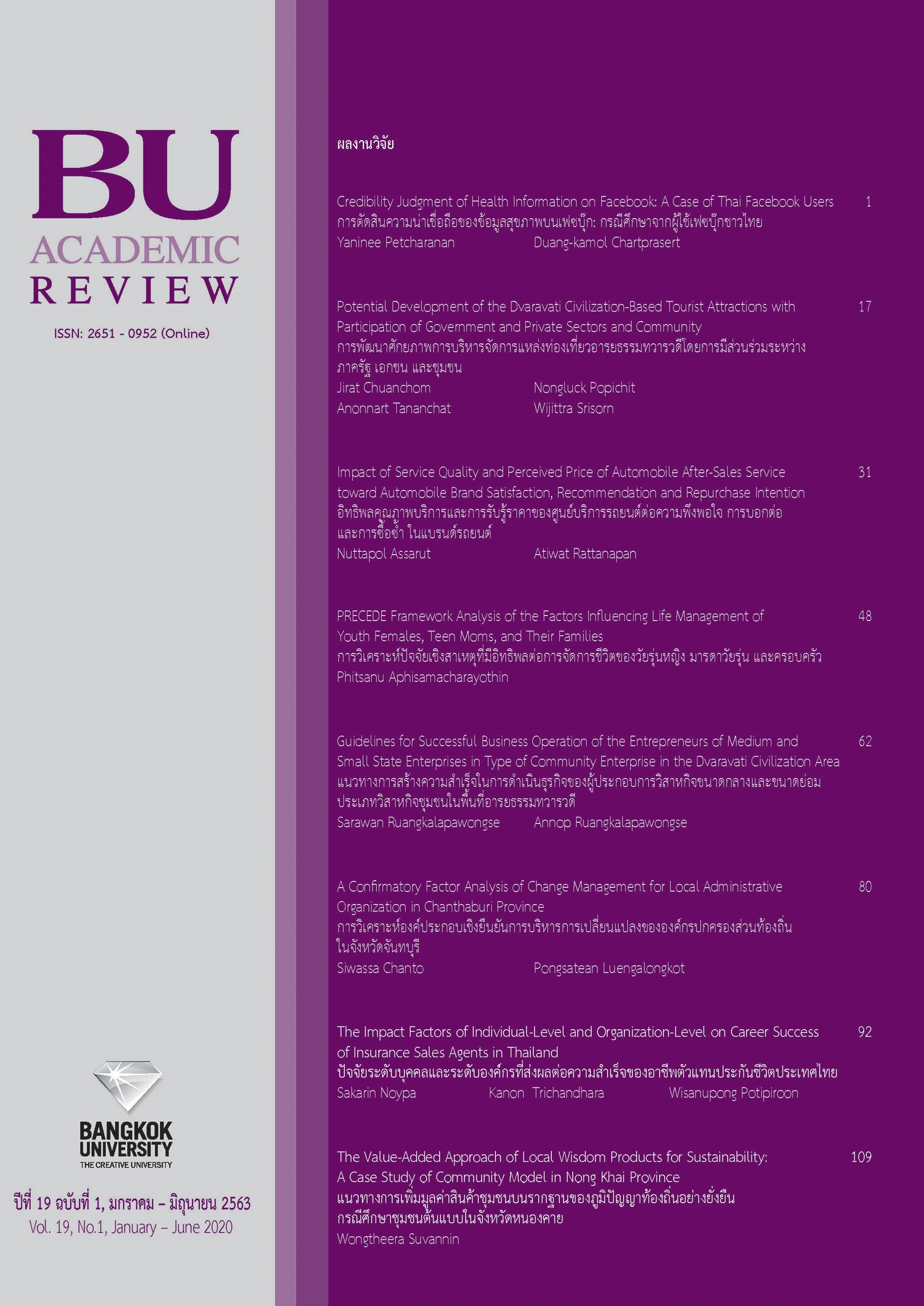ปัจจัยผลักดันการท่องเที่ยวสถานที่ถ่ายทำภาพยนตร์เกาหลี
Main Article Content
บทคัดย่อ
ภาพยนตร์นับได้ว่าเป็นหนึ่งในกลยุทธ์การตลาดทางอ้อมที่ทรงพลังในการส่งเสริมการท่องเที่ยว งานวิจัยที่ผ่านมาได้ชี้ให้เห็นว่าภาพยนตร์ช่วยสร้างการรับรู้และเพิ่มเสน่ห์ให้แก่สถานที่ถ่ายทำภาพยนตร์ได้ ในปัจจุบันนี้พบว่างานวิจัยซึ่งทดสอบว่าภาพยนตร์นั้นสามารถกระตุ้นให้เกิดความต้องการที่จะเดินทางไปท่องเที่ยวยังสถานที่ถ่ายทำภาพยนตร์ได้หรือไม่นั้น ยังได้รับความสนใจอยู่น้อยมาก งานวิจัยนี้จึงได้ศึกษาความแตกต่างระหว่างผู้ที่ชมและผู้ที่ไม่ได้ชมภาพยนตร์เกาหลี เพื่อเปรียบเทียบว่าภาพยนตร์เป็นปัจจัยผลักดันให้ผู้ชมไปเที่ยวสถานที่ถ่ายทำภาพยนตร์เกาหลีได้อย่างไร โดยเก็บข้อมูลจากกลุ่มตัวอย่างนักท่องเที่ยวชาวไทย ผลวิจัยชี้ให้เห็นว่าภาพยนตร์เกาหลีสามารถเป็นปัจจัยผลักดันให้ผู้ชมไปเที่ยวสถานที่ถ่ายทำภาพยนตร์เกาหลี และปัจจัยผลักดันระหว่างผู้ที่ชมและผู้ที่ไม่ได้ชมภาพยนตร์เกาหลีนั้นมีความแตกต่างกัน ผลการวิจัยนี้ย่อมเป็นประโยชน์ต่อทฤษฎีด้านการท่องเที่ยวเชิงภาพยนตร์ และอุตสาหกรรมท่องเที่ยวในการนำภาพยนตร์มาช่วยในการทำการตลาดให้แก่แหล่งท่องเที่ยวเป้าหมายได้
Article Details
บทความที่นำมาสมัครลงตีพิมพ์ในวารสารต้องไม่เคยได้รับการตีพิมพ์เผยแพร่มาก่อน และไม่ส่งต้นฉบับบทความซ้ำซ้อนกับวารสารอื่น รวมทั้งผู้เขียนบทความต้องไม่ละเมิดหรือคัดลอกผลงานของผู้อื่น
เอกสารอ้างอิง
Barameeratanachai, F. (2008). The influence of Korean drama series on visiting Korea: A case study of Thai people in Bangkok (Master’s thesis, Naresuan University).
Beeton, S. (2001). Smiling for the camera: The influence of film audiences on a budget tourism destination. Tourism, Culture and Communication, 3, 15-25.
Beeton, S. (2004). Rural tourism in Australia: Has the gaze altered? Tracking rural images through film and tourism promotion. International Journal of Tourism Research, 6(3), 125-135.
Beeton, S. (2005). Film-induced tourism. Clevedon: Channel View Publications.
Beeton, S. (2010). The advance of film tourism. Tourism and Hospitality Planning & Development, 7(1), 1-6.
Buchmann, A., Moore, K., & Fisher, D. (2010). Experiencing film tourism: Authenticity and fellowship. Annals of Tourism Research, 37(1), 229-248.
Busby, G., & Klug, J. (2001). Movie-induced tourism: The challenge of measurement and other issues. Journal of Vacation Marketing, 7(4), 316-332.
Butler, R. W. (1990). The influence of the media in shaping international tourist patterns. Tourism Recreation Research, 15(2), 46-53.
Carl, D., Kindon, S., & Smith, K. (2007). Tourists’ experiences of film locations: New Zealand as ‘Middle Earth’. Tourism Geographies, 9(1), 49-63.
Chuttrsakulphairatch, V. (2014). The effects of Korean TV dramas on Korean values assimilation and culture imitation of the Thai youth. Panyapiwat Journal, 6(1), 175-185.
Connell, J. (2012). Film tourism: Evolution, progress and prospects. Tourism Management, 33(5), 1007-1029.
Crompton, J.L. (1979). Motivations for pleasure vacation. Annals of Tourism Research, 6(4), 408-424.
Croy, G., & Heitmann, S. (2011). Tourism and film. In P. Robinson, S. Heitmann, & P. Dieke (Eds.), Research Themes for Tourism (pp. 188-204). Oxon: CABI.
Dann, G. (1977). Anomie, ego-enhancement and tourism. Annals of Tourism Research, 4(4), 184-194.
Dann, G. (1981). Tourist motivation: An appraisal. Annals of Tourism Research, 8(2), 187-219.
Fernandez-Young, A., & Young, R. (2008). Measuring the effects of film and television on tourism to screen locations: A theoretical and empirical perspective. Journal of Travel & Tourism Marketing, 24(2-3), 195-212.
Hao, X., & Ryan, C. (2013). Interpretation, film language and tourist destinations: A case study of Habiscus town, China. Annals of Tourism Research, 42, 334-358.
Hudson S., & Ritchie, J. R. B. (2006). Film tourism and destination marketing: The case of Captain Corelli’s Mandolin. Journal of Vacation Marketing, 12(3), 256-268.
Inchan, N. (2013). Korean drama series: A case study of Korean culture fever wave in Thai society context] (Doctoral dissertation, Srinakharinwirot University).
Iwashita, C. (2006). Media representation of the UK as a destination for Japanese tourists: Popular culture and tourism. Tourist Studies, 6(1), 59-77.
Kim, S. (2012a). The relationships of on-site film-tourism experiences, satisfaction, and behavioural intentions: The case of Asian audience’s responses to a Korean historical TV drama. Journal of Travel & Tourism Marketing, 29(5), 472-484.
Kim, S. S. (2012b). Audience involvement and film tourist experiences: Emotional places, emotional experiences. Tourism Management, 33, 387-396.
Kim, S. S., Agrusa, J., Lee, H., & Chon, K. (2007). Effects of Korean television dramas on the flow of Japanese tourists. Tourism Management, 28(5), 1340-1353.
Kim, S., Kim, S., & King, B. (2019). Nostalgia film tourism and its potential for destination development, Journal of Travel & Tourism Marketing, 36(2), 236-252.
Kim, S., & O’Connor, N. (2011). A cross-cultural study of screen-tourists’ profiles. Worldwide Hospitality and Tourism Themes, 3(2), 141-158.
Kim, S., & Wang, H. (2012). From television to the film set: Korean drama Daejanggeum drives Chinese, Taiwanese, Japanese and Thai audiences screen-tourism. The International Communication Gazette, 74(5), 423-442.
Korean Tourism Organization. (2017). Hallyu items. Retrieved February 25, 2017, from http://english.visitkorea.or.kr/enu/SH/whatToBuy/whatToBuy.jsp?action=item&cid=995854
Krippendorf, J. (1990). The holidaymaker: Understanding the impact of leisure and travel. Oxford: Heinemann
Lersakvanitchakul, K. (2018). Riding the Korean wave. Retrieved November 25, 2019, from https://www.nationthailand.com/lifestyle/30348343
Macionis, N. (2004). Understanding the film-induced tourism. In W. Frost, W.G. Croy, & S. Beeton (Eds.). International Tourism and Media Conference Proceedings 24th-26th November 2004 (pp. 86-97). Melbourne: Tourism Research Unit, Monash University.
Macionis, N., & Sparks, B. (2009) Film-induced tourism: An incidental experience. Tourism Review International, 13(2), 93-101.
Ministry of Tourism and Sports (2019). Tourism expenditure by outgoing Thai travellers. Retrieved August 5, 2019, from https://www.mots.go.th/more_news.php?cid=530&filename=index
Peaslee, R.M. (2011). Approach to media power one ring, many circles: The hobbit on tour experience and a spatial approach to media power. Tourist Studies, 11(1), 37-53.
Rajaguru, R. (2014). Motion picture-induced visual, vocal and celebrity effects on tourism motivation: Stimulus organism response model. Asia Pacific Journal of Tourism Research, 19(4), 375-388.
Rewtrakunphaiboon, W. (2017). An exploratory research on perceived destination attractiveness from viewing Korean film of Thai private university students: A case study of Bangkok University. BU Academic Review, 16(1), 115-128.
Riley, R. W., & Van Doren, C. S. (1992). Movies as tourism promotion: A ‘pull’ factor in a ‘push location’. Tourism Management, 13(3), 267-274.
Rittichainuwat, B., & Rattanaphinanchai, S. (2015). Applying a mixed method of quantitative and qualitative design in explaining the travel motivation of film tourists in visiting a film-shooting destination. Tourism Management, 46, 136-147.
Srisurin, P. (2016). Key cultural elements influencing the South Korea’s nation-brand preference in Bangkok. Panyapiwat Journal, 8(1), 1-13.
Turner, G. (1988). Film as social practice. London: Routledge.
Wongkhao, K. (2007). Thai Korean drama series with cultural diffusion in Thai society (Master’s thesis, Thammasat University).
Yoon, Y., & Uysal, M. (2005). An examination of the effects of motivation and satisfaction on destination loyalty: A structural model. Tourism Management, 26, 45-56.


